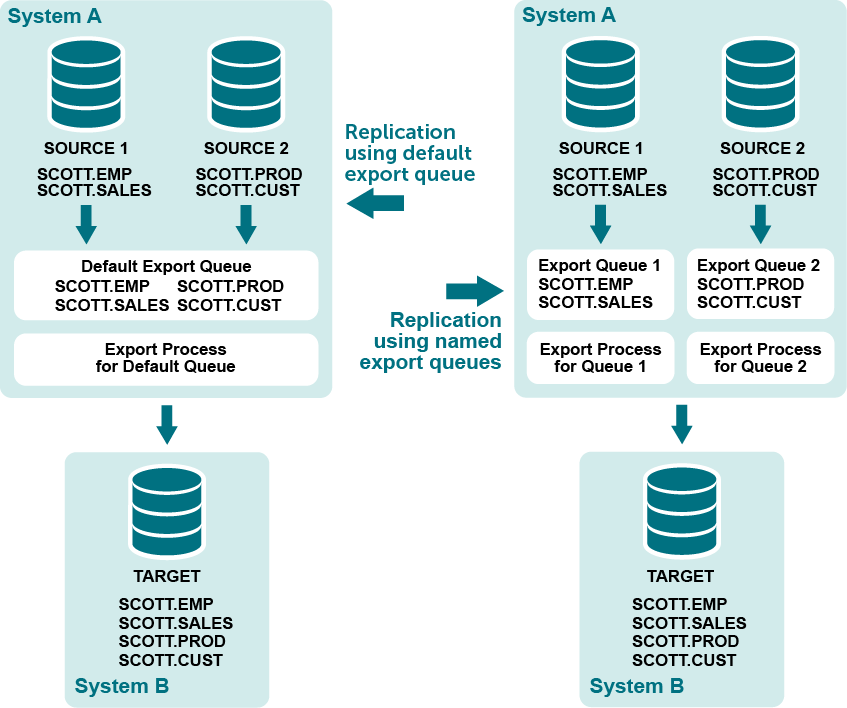A named export queue is an optional, user-defined export queue that is attached to its own Export process. SharePlex creates each named Export queue and associated Export process in addition to the default export queue-process pair. When SharePlex creates a named export queue-process pair, it also creates a dedicated Import process, post queue, and Post process on the target to contain that data stream.
You direct SharePlex to create one or more named export queues when you create your configuration file. Any data that is not configured for processing through a named export queue is processed through the default export queue.

Oracle
All
Use named export queues to isolate the replication of:
Additional benefits:
You can combine named export queues with default export queues. Tables in the configuration with a standard routing map (targetsys@database_spec without a named queue specification) are replicated through a default export queue.
Note: If Post returns the error message "shs_SEMERR: an error occurred with the semaphore" on a Windows system, the number of semaphores may need to be increased to accommodate the queues that you created. For more information, see Post stopped .
Use the following syntax to define a routing map that includes a named export queue.
source_host:export_queuename*target_host[@database]
| Datasource: o.SID | ||
| src_owner.table | tgt_owner.table |
source_host:export_queue*target_host[@database_specification] |
| Routing component | Description |
|---|---|
| source_host | The name of the source system. |
| export_queue |
The name of the export queue. Queue names are case-sensitive on all platforms. Use one word only. Underscores are permissible, for example: sys1:export_q1*sys2@o.myora |
| target_host | The name of the target system. |
| database specification |
One of the following for the datasource: o.oracle_SID r.database_name
One of the following if the target is a database: o.oracle_SID o.tns_alias o.PDBname r.database_name c.oracle_SID |
NoteS:
The following configuration files show two different datasources that are being replicated to two different databases on the same target system. Each datasource is routed through a named export queue.
| Datasource:o.oraA | ||
| scott.emp | scott.emp | sysA:QueueA*sysB@o.oraC |
| scott.sales | scott.sales | sysA:QueueA*sysB@o.oraC |
| Datasource:o.oraB | ||
| scott.prod | scott.prod | sysA:QueueB*sysB@o.oraD |
| scott.cust | scott.cust | sysA:QueueB*sysB@o.oraD |
The following shows how to separate a table that contains LOBs from the rest of the tables by using named export queues.
| Datasource:o.oraA | ||
| scott.cust | scott.cust | sysA:QueueA*sysB@o.oraC |
| scott.sales | scott.sales | sysA:QueueA*sysB@o.oraC |
| scott.prod | scott.prod | sysA:QueueA*sysB@o.oraC |
| scott.emp_LOB | scott.emp_LOB | sysA:QueueB*sysB@o.oraC |
Alternatively, you could simply define a named export queue for the LOB table and allow the remaining tables to be processed through the default export queue.
| Datasource:o.oraA | ||
| scott.cust | scott.cust | sysB@o.oraC |
| scott.sales | scott.sales | sysB@o.oraC |
| scott.prod | scott.prod | sysB@o.oraC |
| scott.emp_LOB | scott.emp_LOB | sysA:lobQ*sysB@o.oraC |
You can view named export queues through sp_ctrl:
See the SharePlex Reference Guide for more infomation about theses commands.